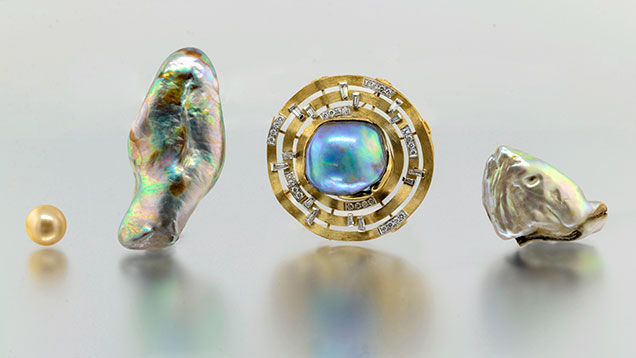Check out these puppies! The one on the left (not the comparison pearl) resembles a hippo's head to me, and I can envision the one that resembles a fish head merging from a south seas color opal, as if to take a snack from someone.
I think you'll agree, these are gorgeous.
Three Unique Large Natural Pearls from Haliotis (Abalone) Species
Joyce Wing Yan Ho and Surjit Dillon Wong

Figure 1. Three unique abalone pearls are shown alongside a typical 12 mm golden South Sea bead-cultured pearl for comparison. Photo by Sood Oil (Judy) Chia.
"Natural abalone pearls are produced by many species of the Haliotis genus, which are ear-shaped saltwater univalve gastropods. They may form in many different sizes and shapes, though they are commonly encountered in baroque shapes, often taking the form of elongated “horns” and “teeth.” The pearls are also notable for their high luster and attractive multicolored appearance, which is usually dominated by blue, green, or yellowish green bodycolors. GIA has reported on many Haliotis pearls in previous Lab Notes over the years (Fall 1984, p. 169; Spring 1996, pp. 47–49; Fall 2004, pp. 259–260; Spring 1993, p. 51).
Three large and unique abalone pearls from a client’s collection were recently submitted to the New York laboratory (figure 1). Each piece was remarkable in its own right. A button-shaped pearl, measuring approximately 26 × 24 mm with impressive vivid “peacock” blue and green hues, was set in a yellow metal brooch. The second piece, seen in figure 1 on the far right, was a loose abalone pearl weighing 66.83 ct and measuring approximately 42 × 26 × 19 mm with a striking resemblance to a fish’s head. The eye, mouth, and gill features were clearly outlined in the specimen, which possessed a smooth surface and subtle array of iridescent greenish yellow colors. The third piece, weighing 113.58 ct and measuring approximately 62 × 29 × 16 mm, was also loose and resembled the head of a snake. It exhibited strong iridescence with mottled patches of various colors similar to the pattern observed on the scaly skin of snakes.

Figure 2. All three specimens from figure 1 showed concentric and void-related internal structures typical of abalone pearls. Images by Surjit Dillon Wong.
Microradiography revealed ... "
https://www.gia.edu/gems-gemology/fall- ... ne-species